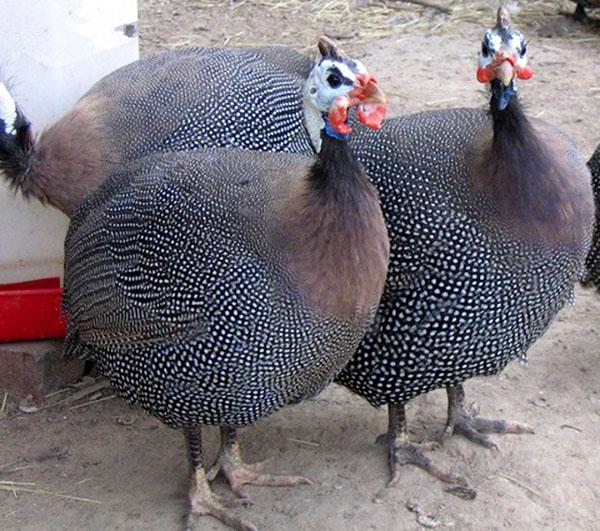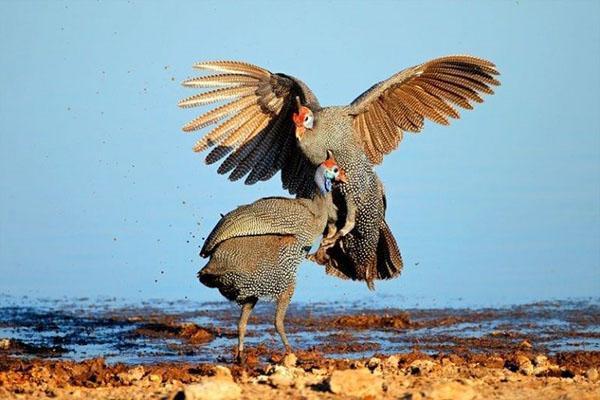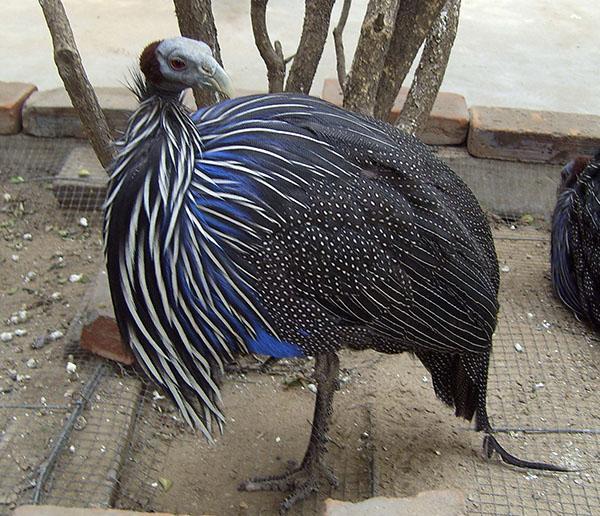Breeding and keeping guinea fowl at home
 The exotic bird resembles chicken and turkey in appearance. Unpretentious guinea fowls can easily tolerate breeding and keeping at home. The royal bird has special requirements for its habitat, but they are doable. Learn more about caring for beautiful, healthy birds to help a beginner avoid mistakes.
The exotic bird resembles chicken and turkey in appearance. Unpretentious guinea fowls can easily tolerate breeding and keeping at home. The royal bird has special requirements for its habitat, but they are doable. Learn more about caring for beautiful, healthy birds to help a beginner avoid mistakes.
What attracts guinea fowls
What kind of guinea fowl is in the wild? Large beautiful schooling bird living in the forests of Africa, Madagascar. Later, the birds were brought to Ancient Greece. The flock obeys the leader, birds spend the night in the trees.
A rare breed of birds for modern Russia has always been an adornment of the possessions of wealthy people in Europe and the homeland. Beautiful large guinea fowls grazed on green lawns and forest edges, invariably returning to the feeders at mealtime. In total, there are 25 species of exotics, but only domestic gray guinea fowl is suitable for breeding.
The ability of birds not to harm crops is used by farmers by launching a flock to peck Colorado beetles, insects and caterpillars into the garden. Guinea fowl feathers are used to make false eyelashes.
The bird loves freedom, spacious walking. In a closed circuit, there can be 2 individuals per square meter without harm to health. Guinea fowls are bad mothers. The incubation period is 29 days. The parent flock can consist of 6 females and one caesar. Mating takes place only while walking. An inseminated female lays fertilized eggs for 20 days. Suitability for bookmarking incubator clean eggs with proper storage - 2 weeks.
At home, breeding and keeping guinea fowls is beneficial:
- guinea fowl eggs are hypoallergenic and are valued in the market five times more than chicken eggs;
- the individual is larger than chicken and the meat contains more hemoglobin;
- the shelf life of eggs, if stored correctly, is a year;
- bird feathers are used to make decorative and artistic items.
- an exotic bird is readily and dearly bought for keeping in a country estate.
How to organize the maintenance of guinea fowls in the courtyard
 For productive cultivation of guinea fowls at home, it is necessary to purchase thoroughbred birds. Siberian white and Zagorsk white-breasted guinea fowls are popular in home breeding. At 3 months, the young are already gaining 1.3 kg of weight. Adults gain up to 2 kg of weight, and the female is heavier than the male.
For productive cultivation of guinea fowls at home, it is necessary to purchase thoroughbred birds. Siberian white and Zagorsk white-breasted guinea fowls are popular in home breeding. At 3 months, the young are already gaining 1.3 kg of weight. Adults gain up to 2 kg of weight, and the female is heavier than the male.
Breeding guinea fowls at home for beginners is available for many reasons:
- A heated room is not required to keep the flock. Birds are able to withstand frost up to - 550 C, but extreme conditions should not be created.
- The birds know their flock well, keep in groups. They distinguish the owner and do not shy away from him. When an outsider appears in the field of view, they shout, thereby the guard of the courtyard.
- Guinea fowls can be released to graze in the garden, they do not rake the ground, do not peck leaves, they look for beetles and worms on the soil surface.
- Not expensive feeding, since half the daily allowance is made up of greens, boiled root vegetables, zucchini, cucumbers, pumpkin.
- Keeping in unheated rooms with dry bedding and equipped perches.
Based on the conditions of keeping guinea fowls at home, breeding them is available even in the country.
Birds can go to free grazing in the nearest coppice.If they are not attracted to the corral with tasty food at night, the guinea fowls settle for the night in the trees, gradually becoming wild.
Breeding conditions
 Day-old chicks are usually purchased and raised in brooder, which replaces the mother hen. From the first day nimble chicks are ready to fly and they are immediately trimmed with the tassels of their wings.
Day-old chicks are usually purchased and raised in brooder, which replaces the mother hen. From the first day nimble chicks are ready to fly and they are immediately trimmed with the tassels of their wings.
It is much more interesting to get your own brood of guinea fowls and watch the family with affection when the mother drives the kids. However, good mothers rarely appear among guinea fowls, and at home you will have to use an incubator to grow guinea fowls.
The parent stock should be composed of several females and a male.
But the difficulty is how to distinguish a female from a male guinea fowl. They are similar, and only by small signs can you find a male. Considering that he should be the oldest in the parent flock, he should be selected from the chicks of the previous brood.
 The search for a male in a flock of adult birds can be started by determining the weight of each individual. More often females are noticeably heavier, larger in size. This is the first, but not the only sign:
The search for a male in a flock of adult birds can be started by determining the weight of each individual. More often females are noticeably heavier, larger in size. This is the first, but not the only sign:
- The structure of the head and beak of birds varies by gender. The females have a small graceful beak, she holds the head straight. The male has a thick beak, with a clearly visible outgrowth, the crest is bent, looks more massive. The head on a short neck is always extended forward.
- Males of Volga white and Volga cream breeds have lighter plumage.
- To determine the sex of the chicks, you need to carefully take the chick, gently open the cloaca, where you will find a small tubercle. This is the henchman.
- The earrings under the beak of young guinea fowls are tender, while in males they are fleshy and large. Over the years, and guinea fowl grow large earrings.
- Caesars, like roosters, stand out in a flock of posture. They walk with their tail and head raised importantly, while females peck modestly and seek food. At the same time, the males crackle on every occasion, and the females utter: "y-a".
 So, we found a male, chose 5-6 productive females in the second year of life, and you need to give them a walk. Indoors, these birds do not mate. Having organized the parent flock, it is necessary to store the collected eggs vertically, with a blunt end towards the sky. They must be kept clean, as dirt clogs the pores and the embryo may not develop. It is necessary to collect the masonry before 12 noon.
So, we found a male, chose 5-6 productive females in the second year of life, and you need to give them a walk. Indoors, these birds do not mate. Having organized the parent flock, it is necessary to store the collected eggs vertically, with a blunt end towards the sky. They must be kept clean, as dirt clogs the pores and the embryo may not develop. It is necessary to collect the masonry before 12 noon.
If there is a hen among the guinea fowls, good. If not, eggs are placed in an incubator for 29 days with technology coups. To hatch chicks, you need to provide increased humidity in the incubator.
Development of guinea fowls from hatching to laying hens
 Can hatch and grow chicken or turkey. They are more caring towards babies than guinea fowl. She may be with a brood, but in case of rain or danger she only cares about herself. If the brood was assigned to a bird, then a kindergarten must be organized. In the middle of the walk, a temporary house is placed - a shelter from the weather and for the night for the family. There are perches, feed is brought there. The mother and the brood take care of the first few days, until the princes acquire a herd reflex and determine the teacher as a leader.
Can hatch and grow chicken or turkey. They are more caring towards babies than guinea fowl. She may be with a brood, but in case of rain or danger she only cares about herself. If the brood was assigned to a bird, then a kindergarten must be organized. In the middle of the walk, a temporary house is placed - a shelter from the weather and for the night for the family. There are perches, feed is brought there. The mother and the brood take care of the first few days, until the princes acquire a herd reflex and determine the teacher as a leader.
If babies are kept in a brooder, then it is necessary to organize proper lighting, feeding, and provide heat. The chicks are fed a special diet for the first 3 months. There should always be fresh water in the drinker, and gravel and shells in a separate feeder or in bulk.
 The temperature in the brooder should be:
The temperature in the brooder should be:
- first 3 days - 360 FROM;
- from 4 to 10 days - 300 FROM;
- from 11 to 20 days - 270 FROM;
- later not lower than 180 FROM.
Up to three months, lighting should be around the clock, then every week the day is shortened by an hour, up to 5 months. Then they add again weekly for an hour, regardless of the season, creating illumination in the poultry house for 17 hours.
Guinea fowl eggs have unique qualities. The protein has bactericidal properties, it is used as part of drugs for the eyes, for gastrointestinal ailments.Meat contains 95 amino acids and is useful for pregnant women, women in labor, and people weakened by diseases.
Under these conditions, females become sexually mature at the age of six months. The time of active clutch is commensurate with the biological cycle of offspring reproduction.
 Guinea fowls begin to lay eggs actively when the weather is favorable for breeding.
Guinea fowls begin to lay eggs actively when the weather is favorable for breeding.
Laying begins in February, but males start mating only in March. The peak of activity occurs at an air temperature of 17-200 C and the duration of natural light is 14 hours.
Breeding guinea fowls is no more difficult than other poultry. Guinea fowl meat is valued, the average cost per kilogram is 400 rubles. The production is waste-free, even guinea fowl feathers are used in art workshops, and not for stuffing pillows.